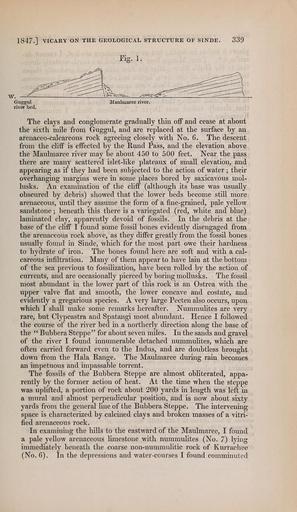MAKE A MEME
View Large Image

| View Original: | The_Quarterly_journal_of_the_Geological_Society_of_London_(13206068703).jpg (1199x2069) | |||
| Download: | Original | Medium | Small | Thumb |
| Courtesy of: | commons.wikimedia.org | More Like This | ||
| Keywords: The Quarterly journal of the Geological Society of London (13206068703).jpg 184/ VICARY ON THE GEOLOGICAL STRUCTURE OF SINDE 339 <br> Fig 1 <br> The clays and conglomerate gradually thin off and cease at about <br> the sixth mile from Guggul and are replaced at the surface by an <br> arenaceo-calcareous rock agreeing closely with No 6 The descent <br> from the cliff is effected by the Rund Pass and the elevation above <br> the Maulmaree river may be about 450 to 500 feet Near the pass <br> there are many scattered islet-like plateaux of small elevation and <br> appearing as if they had been subjected to the action of water ; their <br> overhanging margins were in some places bored by saxicavous mol- <br> lusks An examination of the cliff although its base was usually <br> obscured by debris showed that the lower beds become still more <br> arenaceous until they assume the form of a fine-grained pale yellow <br> sandstone ; beneath this there is a variegated red white and blue <br> laminated clay apparently devoid of fossils In the debris at the <br> base of the cliff I found some fossil bones evidently disengaged from <br> the arenaceous rock above as they differ greatly from the fossil bones <br> usually fomid in Sinde which for the most part owe their hardness <br> to hydrate of iron The bones found here are soft and with a cal- <br> careous infiltration Many of them appear to have lain at the bottom <br> of the sea previous to fossilization have been rolled by the action of <br> currents and are occasionally pierced by boring mollusks The fossil <br> most abundant in the lower part of this rock is an Ostrea with the <br> upper valve flat and smooth the lower concave and costate and <br> evidently a gregarious species A very large Pectenalso occurs upon <br> which I shall make some remarks hereafter Nummulites are very <br> rare but Clypeastra and Spatangi most abundant Hence I followed <br> the course of the river bed in a northerly direction along the base of <br> the Bubbera Steppe for about seven miles In the sands and gravel <br> of the river I found innumerable detached nummulites which are <br> often carried forward even to the Indus and are doubtless brought <br> down from the Hala Range The Maulmaree during rain becomes <br> an impetuous and impassable torrent <br> The fossils of the Bubbera Steppe are almost obliterated appa- <br> rently by the former action of heat At the time when the steppe <br> was uplifted a portion of rock about 200 yards in length was left in <br> a mural and almost perpendicular position and is now about sixty <br> yards from the general line of the Bubbera Steppe The intervening <br> space is characterized by calcined clays and broken masses of a vitri- <br> fied arenaceous rock <br> In examining the hills to the eastward of the Maulmaree I found <br> a pale yellow arenaceous limestone with nummulites No 7 lying <br> immediately beneath the coarse non-nummulitic rock of Kurrachee <br> No 6 In the depressions and water-courses I found comminuted 36933098 113687 51125 Page 339 Text v 3 http //www biodiversitylibrary org/page/36933098 1847 Geological Society of London NameFound Hala NameConfirmed Hala EOLID 113195 NameBankID 4551297 NameFound Nummulites NameConfirmed Nummulites EOLID 6817785 NameBankID 3399048 NameFound Ostrea NameConfirmed Ostrea EOLID 10719983 NameBankID 2692450 Biodiversity Heritage Library The Quarterly journal of the Geological Society of London v 3 1847 Geology Periodicals Smithsonian Libraries bhl page 36933098 dc identifier http //biodiversitylibrary org/page/36933098 smithsonian libraries Information field Flickr posted date ISOdate 2014-03-17 Check categories 2015 August 26 CC-BY-2 0 BioDivLibrary https //flickr com/photos/61021753 N02/13206068703 2015-08-26 12 54 28 cc-by-2 0 PD-old-70-1923 The Quarterly journal of the Geological Society of London 1847 Photos uploaded from Flickr by Fæ using a script | ||||